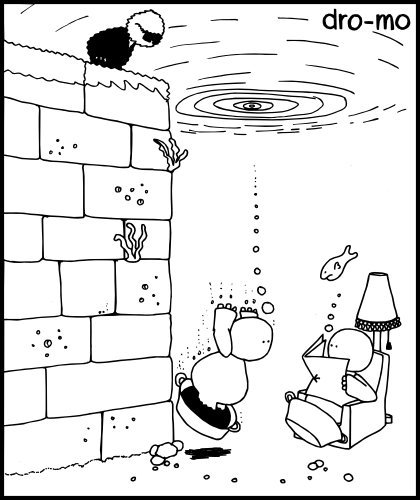![]() Dro-Mo, you are pretty mysterious. What information would you be willing to give our readers about yourself?
Dro-Mo, you are pretty mysterious. What information would you be willing to give our readers about yourself?
You’ll have to say the password before I can disclose any information. Due to my mysteriousness, I wear dark glasses and a heavy overcoat when drawing.
I use black and white and that’s plenty. My cartoons are all about creating a great deal with very little – that’s why the dro-mo character has no expression.
… Wait, I thought you were Dro-Mo.. Now you say one of your characters is.. Who is that Dro-Mo person?
Dro-Mo is the cartoon, the character and anything which lies within the panel. And it’s a word that doesn’t mean anything. No, I don’t understand it either.
On your Website, you display a list of artists that influenced you. I think I see the connection between your art and cartoonists like Miroslav Barták and silent movie stars like Buster Keaton. There are three names, however, I couldn’t really relate to your work… How do George Grosz, Uderzo & Steve Bell fit in there?
I’ve admired Grosz for many years; biting satire and a fantastic pen line. I loved Asterix when I was younger – and I still do. I used to copy out Uderzo’s work during long afternoons in my childhood bedroom. Steve Bell is one of the best political cartoonists about and has skewered many politicians with simple but devastating caricatures. In some way they’ve all fed into my thoughts and approach to cartooning.
 The cartoons in your blog use captions. How important are they for you?
The cartoons in your blog use captions. How important are they for you?
Not really. I prefer no captions but I now use them on the blog so that there’s something to read when links are posted on Twitter.
I noticed that you often construct elaborate spaces in your cartoons, even though they may seem simple at a first glance – take the cubicle cartoon, for example..
That one took quite a while to plan out. Because I don’t use words, the relationship between the characters and the surrounding space is very important. I don’t produce many drafts but I usually sketch out an idea and then leave it for a day or two while I think about it. I work out variations in my mind and then come up with something and things usually fall into place.
In March you wrote that your cartoons were going to be syndicated by Creators Syndicate. How is this coming along?
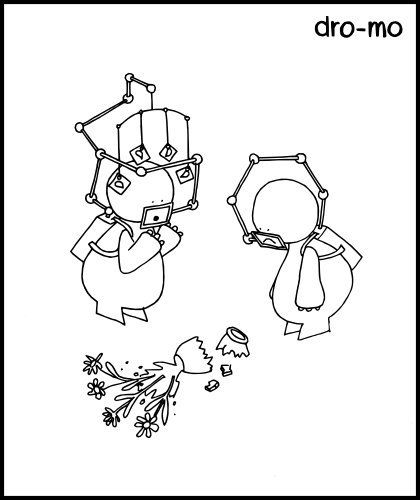 Oh, dro-mo is in development for the first two years and then the syndicate will start selling it. It’s early days yet but hopefully all will go well
Oh, dro-mo is in development for the first two years and then the syndicate will start selling it. It’s early days yet but hopefully all will go well
How did this syndication thing start? Did they approach you or did you apply?
I approached a number of syndicates and publishers with dro-mo but Creators were the first to offer a deal. I simply sent off a letter with examples of the cartoon in the format they wanted and they seemed to like what they saw.
What does “being in development” exactly mean? Do you just stock up on cartoons?
Basically, it means giving me time to build up a profile on the Creators website and a stock of cartoons before dro-mo is offered up for publication. It also allows me to get used to the syndicate’s way of working before the serious work begins. At the moment I’m producing three panels a week; after two years it’ll increase to five – yikes!
Thanks for your time!
]]>
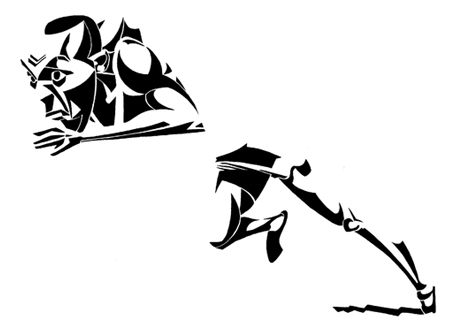
Today’s interview has a bit of a back story: A couple of months ago, I did a special on vector graphics. One of the artists I was planning to do an interview with was Xavier Salvador. Well… it turned out that he doesn’t use vector graphics at all. Of course I asked him, how he achieved his perfect black lines and shapes. Here’s his reply:
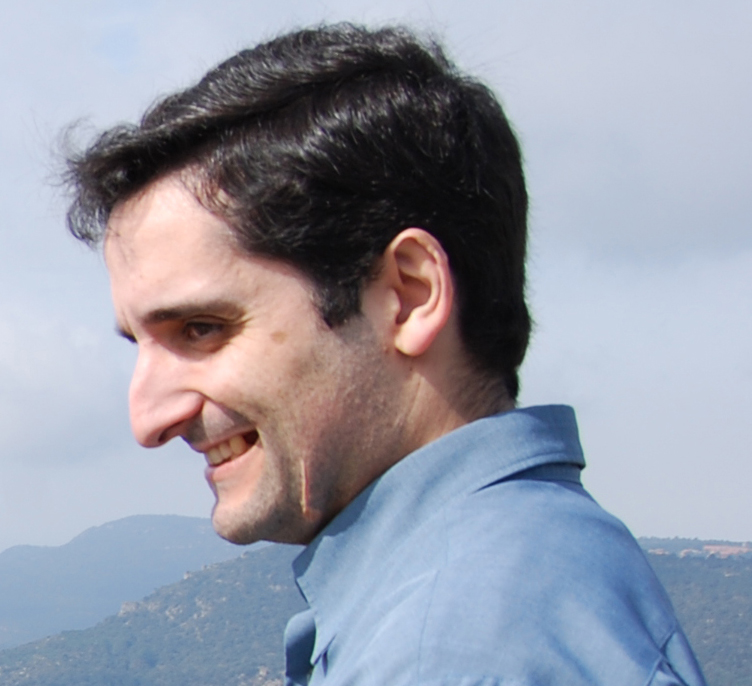 For my caricatures I use a process I invented myself. Some years ago, I used to ink my drawings – but I felt that it would take me years to learn this technique. And I don’t have the time! So I tried this: I do the first sketch and then, instead of inking, I trace with very clean lines of pencil. I scan it, and I darken it in Photoshop. Then I fill in the spaces between lines. Finally, I color the non-white areas and.. voilà! It is a very simple yet effective process.
For my caricatures I use a process I invented myself. Some years ago, I used to ink my drawings – but I felt that it would take me years to learn this technique. And I don’t have the time! So I tried this: I do the first sketch and then, instead of inking, I trace with very clean lines of pencil. I scan it, and I darken it in Photoshop. Then I fill in the spaces between lines. Finally, I color the non-white areas and.. voilà! It is a very simple yet effective process.
[click here to see a work in progress]
About half a year after my first attempt I finally managed to continue the interview:
Xavier, now that I know how your technique works.. Can you tell me how you learned to draw? Did you have any artistic schooling?
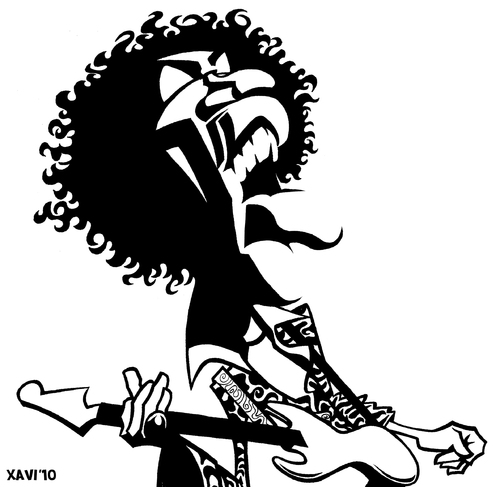 Yes, I studied technical drawing and engineering. This means I know perspective and volumes very well from my youth.
Yes, I studied technical drawing and engineering. This means I know perspective and volumes very well from my youth.
I drew my first caricatures back in university, and I noticed they looked pretty good. That’s why I decided to take a local ‘comic book course’ in my hometown, Reus. My teacher was Marc Sardà, a great illustrator and artist. He opened the door of this world to me, and I’ll be eternally grateful to him.
Do you still change things about your personal style?
Yes, I always want to try something new. Take, for example Matteo Bertelli‘s hair. I had never drawn Rasta hair before…So, I had to try out a couple of different ways of drawing it until I found the right one.
I think we always should try to improve. In my case, I developed from a ”standard” style more or less, to the current one. My objective is this: I want to communicate a maximum of content using a minimum of lines, colors and shapes. I think I have achieved this with the black-and-white style.
The most curious thing is this: one of the reasons that I have reached this goal, it is that I am color-blind – I am frightened of colors! And, obviously, I am more comfortable using black shadows.
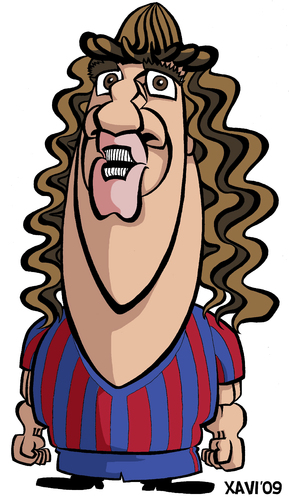 But you do have some colored works in your gallery.. How do you make sure you chose the right colors, say for the FC Barcelona jerseys? Do you memorize their position in Photoshop?
But you do have some colored works in your gallery.. How do you make sure you chose the right colors, say for the FC Barcelona jerseys? Do you memorize their position in Photoshop?
Yeah, you got me! I try to discern them from their position in Photoshop. I also ask my girlfriend to check the colors before I exhibit a picture. Coloring is the hardest part for me!
For some reason, I’ve never asked this question before: How do you decide on whom to draw next?
I like this question. There is more than one motivation to draw a person. Sometimes I like a piece of art created or performed by someone – music, a painting, or a film. Sometimes will draw a person I admire for their career. Or a historic character I have read about, or someone who is in the news. Other times, there is a request. And sometimes I just like the person I am drawing.
Did your new technique change something about the way you perceive lights and shadows?
Of course! I pay attention to light a lot more. For example, when I have to draw a caricature I reject a lot of photos that other artists would use. Why? Because they don’t have shadows, so I can’t see the volumes of the face. Without lights and shadows I can’t develop my drawings. For example, in my version of Michelangelo’s David, I applied a lot of shadows that you almost can’t see in any photo – but I need them to make my drawing live.
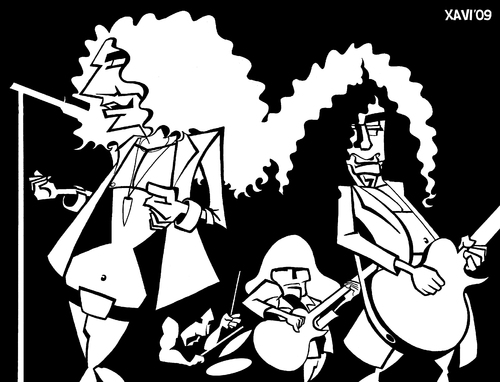 How do you think your style improved over the last few years?
How do you think your style improved over the last few years?
I’d say that now I do a lot more detailed analysis of my ‘victims” faces. I have also become quite meticulous about the shadows and volumes and I try to internalize them. In the last years, developing the style of fragmented shadows has been a step forward, for example in the Jesse Owens piece.
Is there something that you would still like to improve upon?
Yes, one of my weak points is drawing backgrounds, and I love drawing comic books! Therefore I must practice it…
As for human bodies and faces… I have worked with them for a lot of years now, but sometimes I still find another way of drawing something I have already done a thousand times! We can always improve, even on something we perfectly know.
Thanks for your time!
]]>